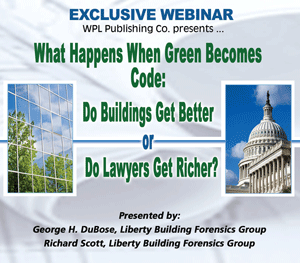ASHRAE produces standards that are adopted by most model building codes, and the ASHRAE Draft Standard 189.1P is the new "Standard for Design of High Performance Green Buildings Except Low-Rise
Residential Buildings."
This new ASHRAE Standard is written in code language and will have the impact of mandating that all new buildings will be green buildings, thus eliminating the option of constructing anything less robust. Even if this standard is not adopted by all model codes, it will become the de facto standard of care.
Increased Expectations from Designers and Contractors
On the surface this sounds like a very good thing - mandating better performing, more energy efficient buildings - and it certainly has many redeeming aspects. But, there are also many challenges that will come with the new building codes: Lack of experience will increase design and construction deficiencies; standard of care will be elevated and because regional issues are not addressed this could create problems with climate-unique requirements. This training CD will prepare you for what's coming:
- Understand that designers and contractors will soon be forced to implement building features that many do not fully understand, leading to more frequent building failures as firms design and construct buildings with complex components in an effort to keep the work coming in.
- Realize that what are now considered "best practices" will soon be considered the minimum standard of care, increasing the risk profile of many projects and potentially triggering some exclusion clauses in current insurance policies.
- See that national mandates rarely take into consideration the unique requirements of differing regions around the country (e.g., hot and humid, very cold, or very rainy climates).
- Acknowledge that the inevitable result will be that everyone will quickly morph into a green practitioner, so that the true marketplace differentiators (those with experience and unique technical expertise) will become difficult to discern, and design and construction deficiencies and lawsuits will increase.
Purchase this training series and you will learn how to:
- Identify the increased risk in your green designed and constructed project due to use of innovative products
- Help you identify LEED credits in your project that may add minimal value but may dramatically increase risk
- Give you a better understanding of the technical concerns of green building failures
Who Will Benefit?
This training CD is a must if you're a public or private owner, design professional, engineer, architect, contractor, subcontractor, manufacturer, supplier or attorney. Purchase Now to gain a better understanding of increased risks that construction professionals face as they go green and how you can minimize your project risks when building green!
Your Presenters:
George DuBose
Liberty Forensics Group
George DuBose, CGC, is a general contractor with a mechanical engineering degree. He¿s also a building forensics expert and Vice President of Building Consulting Services with Liberty Building Forensics Group in Orlando, Florida. He has been a lecturer on building performance problems for more than 10 years, has authored more than 15 technical articles and co-authored three manuals on moisture-related mold problems and commissioning in hot/humid climates, including NCARB's mini-monograph: The Hidden Risks of Green Buildings: Avoiding Moisture & Mold Problems which is proving invaluable in the construction industry and related fields.
Mr. DuBose was technical adviser to the Atlanta Committee for the 1996 Olympic Games. He is also a co-inventor of a hybrid fan coil unit (patent pending) specially designed for hot/humid climate use and installed in more than 10,000 rooms in the Central Florida area and 2,000 rooms in Hawaii. Mr. DuBose has more than 10 years experience in diagnosing, correcting and remediating moisture-related mold problems in buildings.
Richard Scott
Liberty Forensics Group
Richard Scott, RA, AIA, LEED AP, NCARB, is a senior forensic architect registered with the AIA, and specializes in moisture and mold problems with Liberty Building Forensics Group® in Orlando, Florida. He has co-authored both: A CEU monograph for NCARB (the National Council of Architectural Registration Boards) on moisture and mold prevention: Mold & Moisture Prevention and an NCARB mini-monograph, The Hidden Risks of Green Buildings: Avoiding Moisture and Mold Problems.

